This post may contain affiliate links. Please read our disclosure policy.
Making your own homemade pizza sauce might just change how you view pizza nights at home. There’s something so satisfying about crafting that tomatoey goodness from scratch, knowing exactly what’s going into it, and tweaking flavors to your liking. Learn how to make pizza sauce, from scratch with canned tomatoes and herbs.
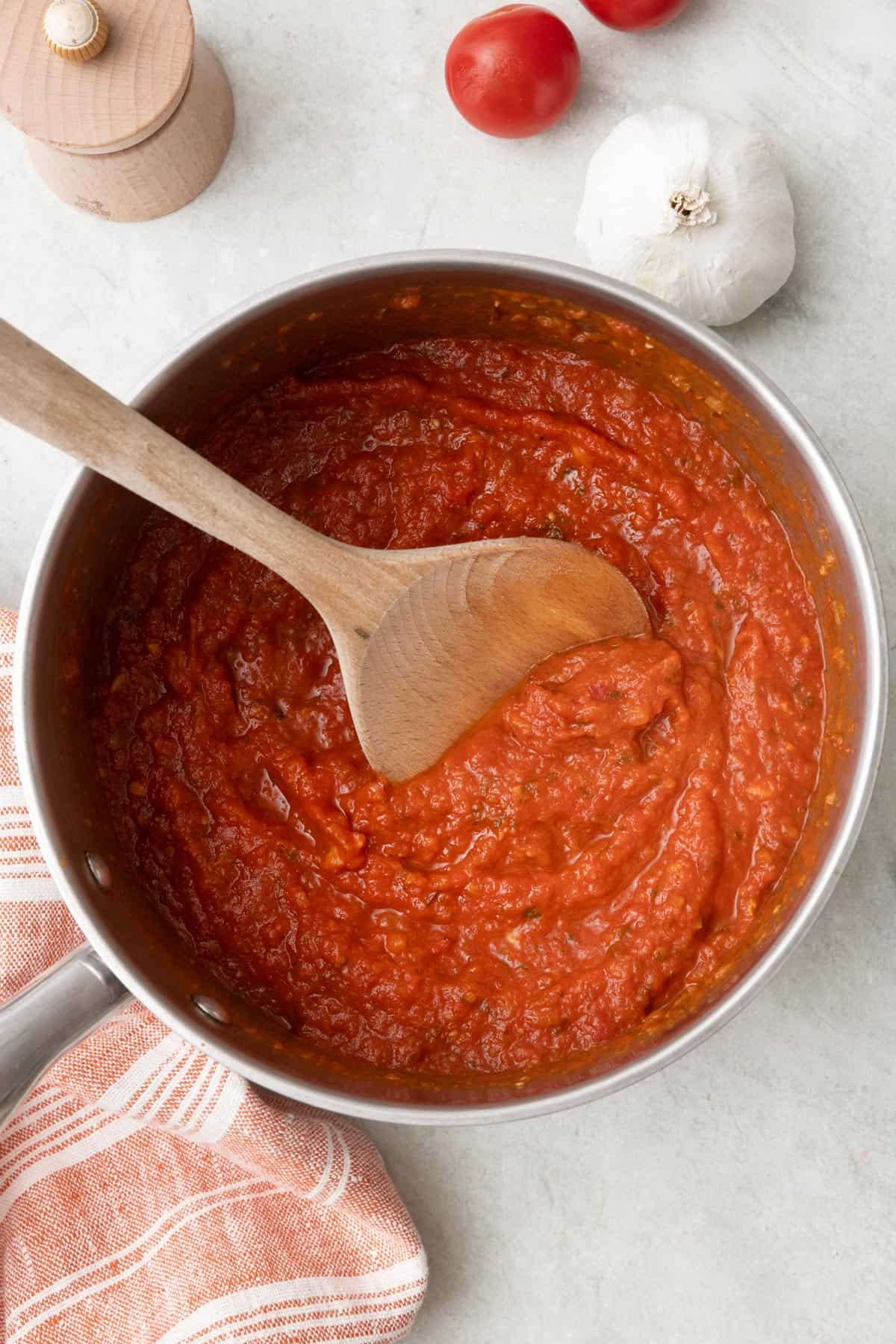
Table of Contents
- WHY LEARN HOW TO MAKE PIZZA SAUCE
- INGREDIENTS TO MAKE HOMEMADE PIZZA SAUCE
- HOW TO MAKE PIZZA SAUCE WITH CANNED TOMATOES
- TIPS FOR THE BEST HOMEMADE PIZZA SAUCE
- RECIPES TO MAKE WITH HOMEMADE PIZZA SAUCE
- HOW TO REHEAT & STORE PIZZA SAUCE
- FREQUENTLY ASKED QUESTIONS
- MORE cooking tutorials:
- How to Make Pizza Sauce Recipe
Ditching the store-bought pizza sauce doesn’t mean spending hours in the kitchen. With this straightforward recipe, you’ll have a rich, flavorful pizza sauce in no time. Let’s get started.
WHY LEARN HOW TO MAKE PIZZA SAUCE
- Homemade pizza sauce is cost-effective. Typically, anything processed, canned, and packaged will cost more than if you were to make it at home from scratch. Save money by doubling the recipe and freezing a batch for later.
- Quick and easy but flavorful. This easy pizza sauce recipe comes together with minimal ingredients but delivers big flavor. It has just the right amount of herbaceous seasonings, savory hints of sauteed onions and garlic, and the sweetness in the tomatoes. And it all comes together with mostly pantry staples and one pan.
- Control quality and freshness. Making homemade pizza sauce from scratch allows you to have full control over the ingredients, ensuring the highest quality and taste. No thickeners, preservatives, or excessive sugars – just enough of homegood deliciousness to make all your pizza dreams come true.
- Good kitchen skill to know. If you love and eat pizza as much as we do, learning how to make pizza sauce with canned tomatoes can transform your homemade pizza nights into a truly special experience. There’s something so uniquely satisfying about knowing that your pizza was crafted from scratch, from start to finish.
INGREDIENTS TO MAKE HOMEMADE PIZZA SAUCE
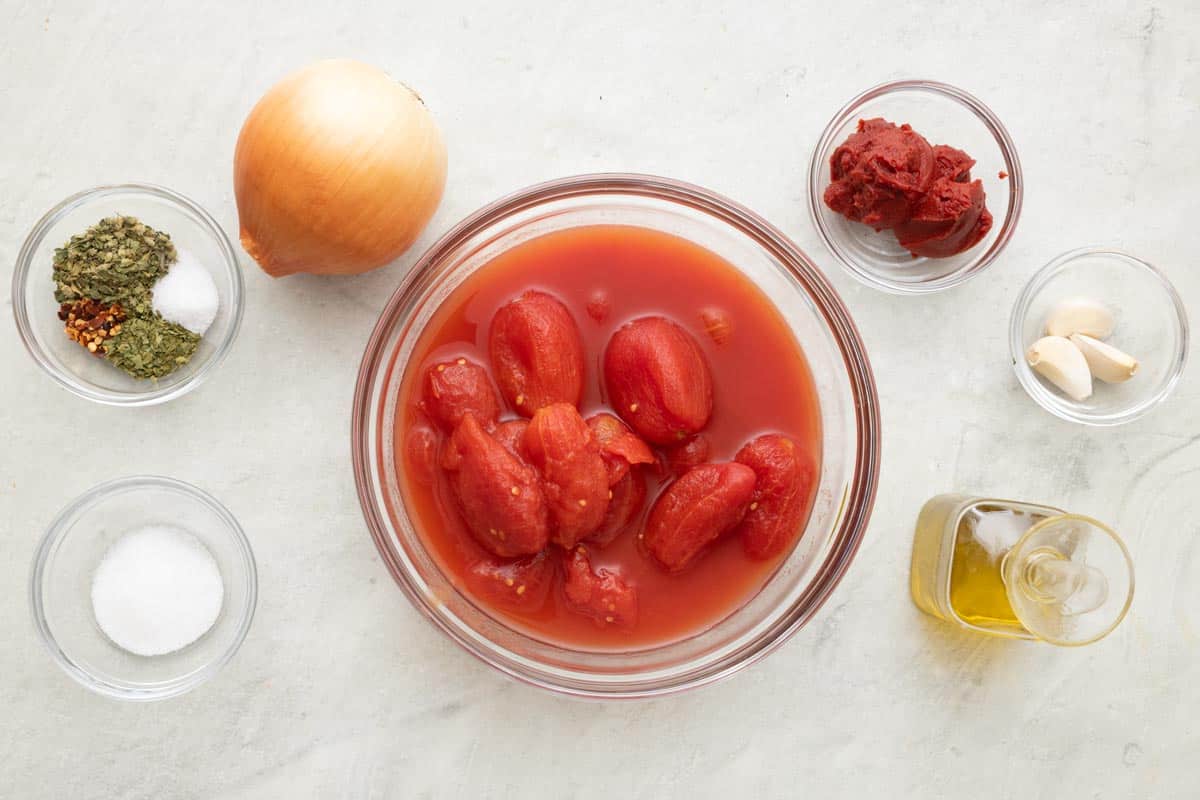
- Olive oil: Used for sauteing onions and garlic and adds a rich texture to the sauce.
- Onion and garlic: Onions add mild sweetness, while garlic adds a robust, savory flavor and complements the canned tomatoes.
- Tomato paste: Concentrated, cooked tomatoes add deep tomato flavor and color. It also helps to thicken the sauce.
- Canned tomatoes: A 28-ounce can of whole tomatoes forms the bulk of the sauce. The simmering process allows them to break down, creating a flavorful and silky sauce.
- Seasonings: Dried oregano, basil, salt, and red pepper flakes are classic seasonings and are enough to flavor this easy pizza sauce recipe.
- Sugar: Sugar balances the acidity of the tomatoes, rounding out the flavor perfectly.
HOW TO MAKE PIZZA SAUCE WITH CANNED TOMATOES
- In a large pan, add oil and heat over medium heat until shimmering. Saute diced onions until soft and translucent. Add garlic and saute until fragrant. Then, add the tomato paste and cook until the color has deepened. [Image 1]
- Add canned tomatoes, dried oregano and basil, salt, red pepper flakes, and sugar to the pan. [Image 2]
- Use a wooden spoon to break the tomatoes into small pieces. [Image 3]
- Bring sauce to a boil, then reduce heat to a gentle simmer over medium heat. [Image 4]
- Simmer until the sauce has thickened, stirring occasionally. [Image 5]
- After cooking, blend the sauce until smooth and no chunks of tomatoes remain. [Image 6]
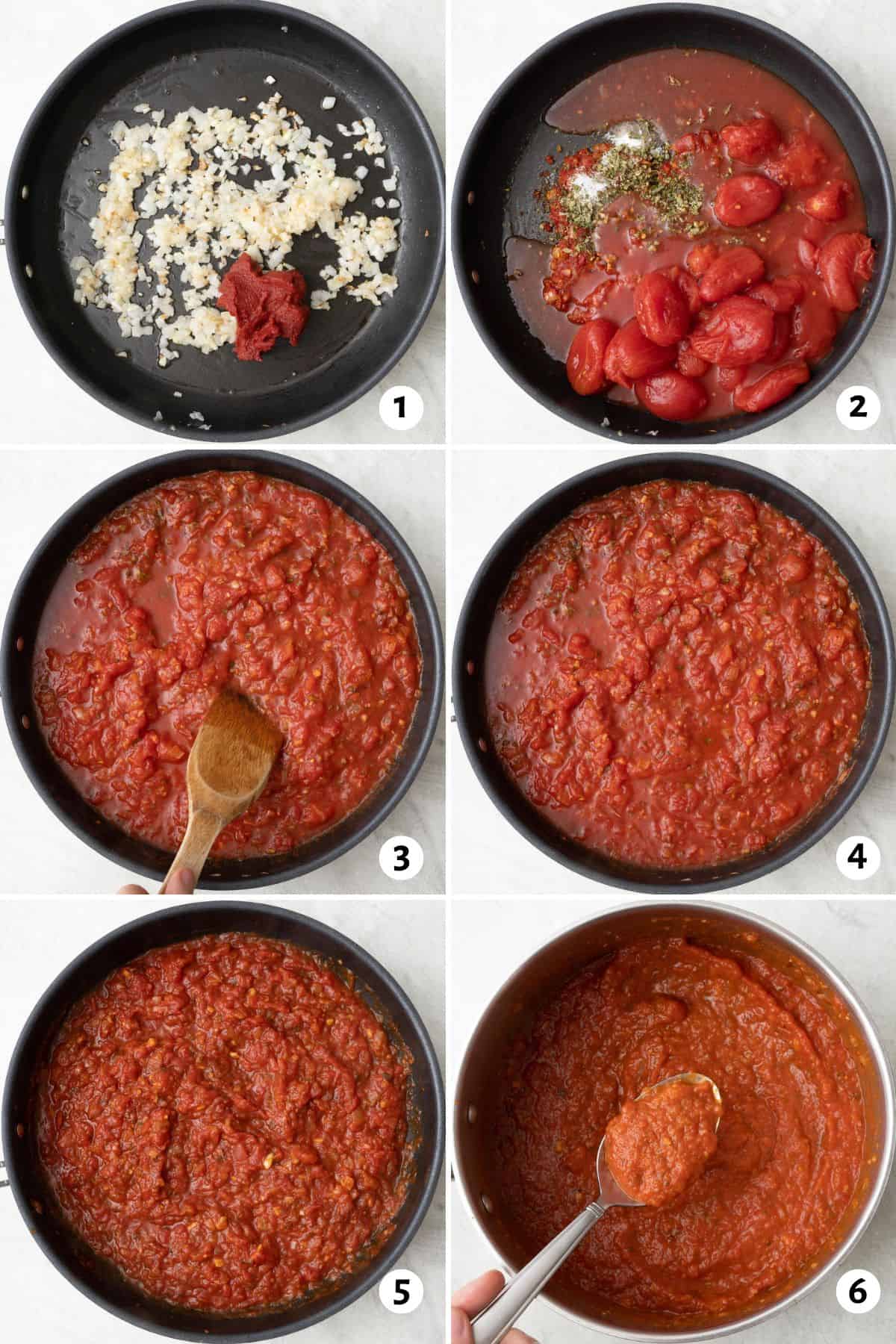
TIPS FOR THE BEST HOMEMADE PIZZA SAUCE
- Simmer for depth of flavor. Let the sauce simmer on medium-low heat to allow flavors to meld. Don’t rush this step, as it helps the sauce develop a richer, more complex flavor profile.
- Thicken naturally. The gentle simmering helps the sauce thicken as excess moisture evaporates. This also helps to keep the ingredients minimal and the sauce flavorful.
- Make blending fuss-free. Use an immersion blender and blend the sauce directly in the pan. Or carefully transfer the sauce to a food processor or blender and blend until smooth.
- Let it cool before using. Allow the sauce to cool slightly before spreading it on the pizza dough to prevent the heat from prematurely cooking it.
RECIPES TO MAKE WITH HOMEMADE PIZZA SAUCE
- Cast Iron Pizza
- Pizza Muffins
- Tortilla Pizza
- Broccoli Crust Pizza
- Pizza Bites
- Sheet Pan Pizza
- Portobello Mushroom Pizzas
- Grilled Pizza
- Upside Down Pizza

HOW TO REHEAT & STORE PIZZA SAUCE
Homemade pizza sauce from scratch doesn’t have preservatives and additives that storebought versions have, so it’s best to store pizza sauce in the refrigerator in air-tight containers or Mason jars. There is no need to reheat the pizza sauce before using it – just slather it on the pizza dough straight from the fridge and continue with the toppings.
HOW LONG WILL PIZZA SAUCE LAST IN THE FRIDGE?
Refrigerated pizza sauce should last for up to 1 week. Stir before using to incorporate any separated liquids.
CAN I FREEZE HOMEMADE PIZZA SAUCE?
Yes! Homemade pizza sauce is very freezer-friendly. I recommend you portion the sauce into freezer-safe containers or freezer bags and freeze for up to 6 months. Thaw overnight in the fridge and give it a good stir before using.
FREQUENTLY ASKED QUESTIONS
Yes! You can swap out dried herbs with fresh ones using a 1:3 ratio. For example, swap out 1 teaspoon of dried basil with 3 teaspoons of finely chopped fresh basil. Keep in mind, that this is a general guideline, and you may need to adjust based on your taste preferences. If using fresh, add them to the sauce towards the end of the cooking process.
Blending the sauce gives a more smooth texture than you would expect on a pizza, but it is completely optional. If you prefer a chunkier sauce, you can skip this step and instead use a wooden spoon to break down the tomatoes to your desired consistency.
Sugar helps to balance the acidity of the tomatoes and enhances the depth and complexity of the sauce. You can reduce the amount or omit it, but it might affect the overall taste. You can also use another sweetener like coconut sugar, honey, or brown sugar. If substituting sweeteners, start low and adjust to your liking.
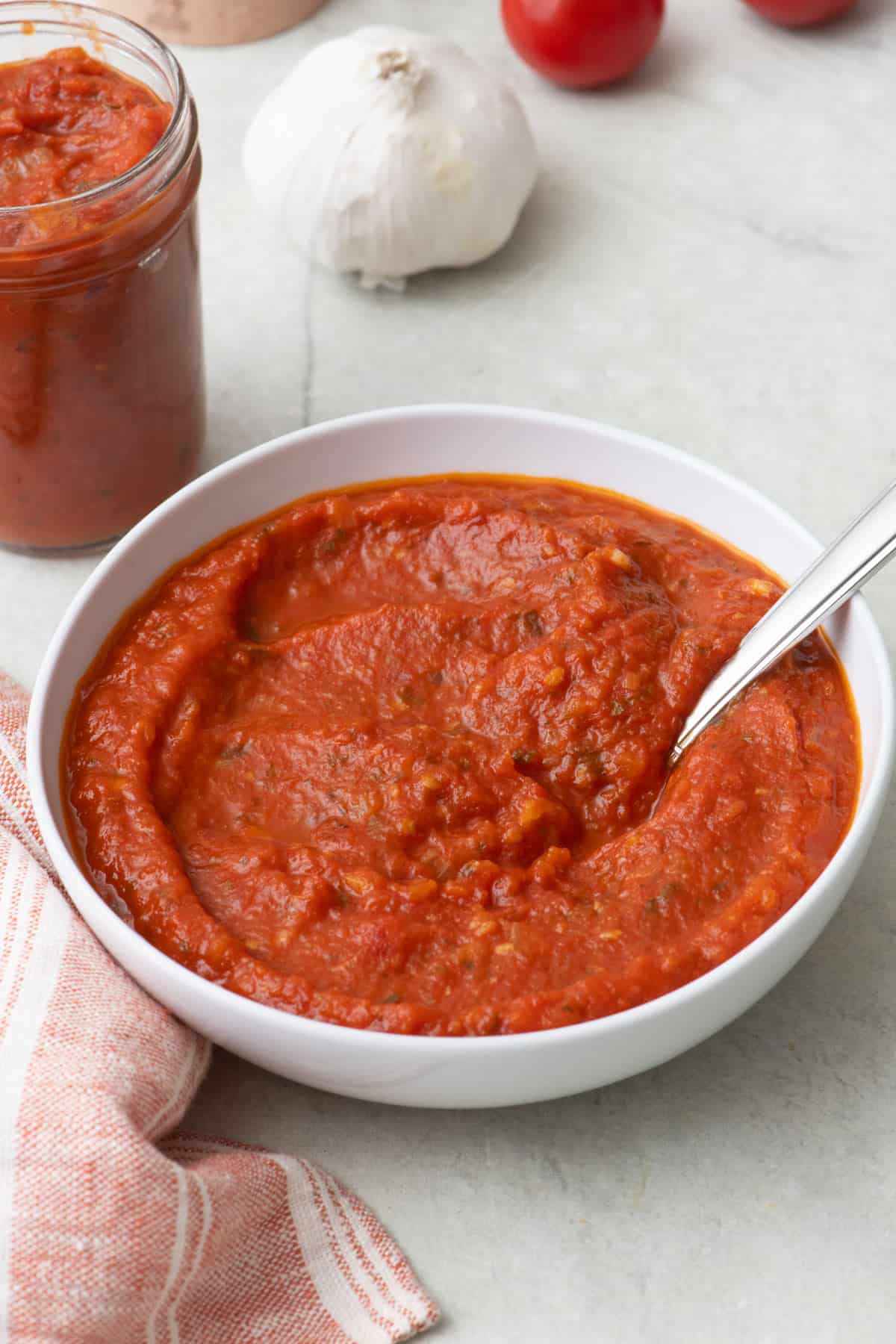
Knowing how to make pizza sauce with canned tomatoes is a worthwhile skill because it can easily take any pizza from good to mouthwatering! Give your pizza a homemade touch with this easy pizza sauce recipe.
MORE cooking tutorials:
- How to Make Pizza Dough
- How to Make Bechamel Sauce
- How to Make Pesto
- How to Peel Garlic Fast
- How to Make Marinara Sauce
- How to Make Balsamic Glaze
- How to Make Yogurt
If you found this tutorial for How to Make Pizza Sauce helpful or if you try any recipe on Feel Good Foodie, then don’t forget to rate the recipe and leave a comment below! It helps others who are thinking of trying out this tutorial and we would love to hear about your experience. And if you snapped some shots, share it on Instagram so we can repost on Stories!
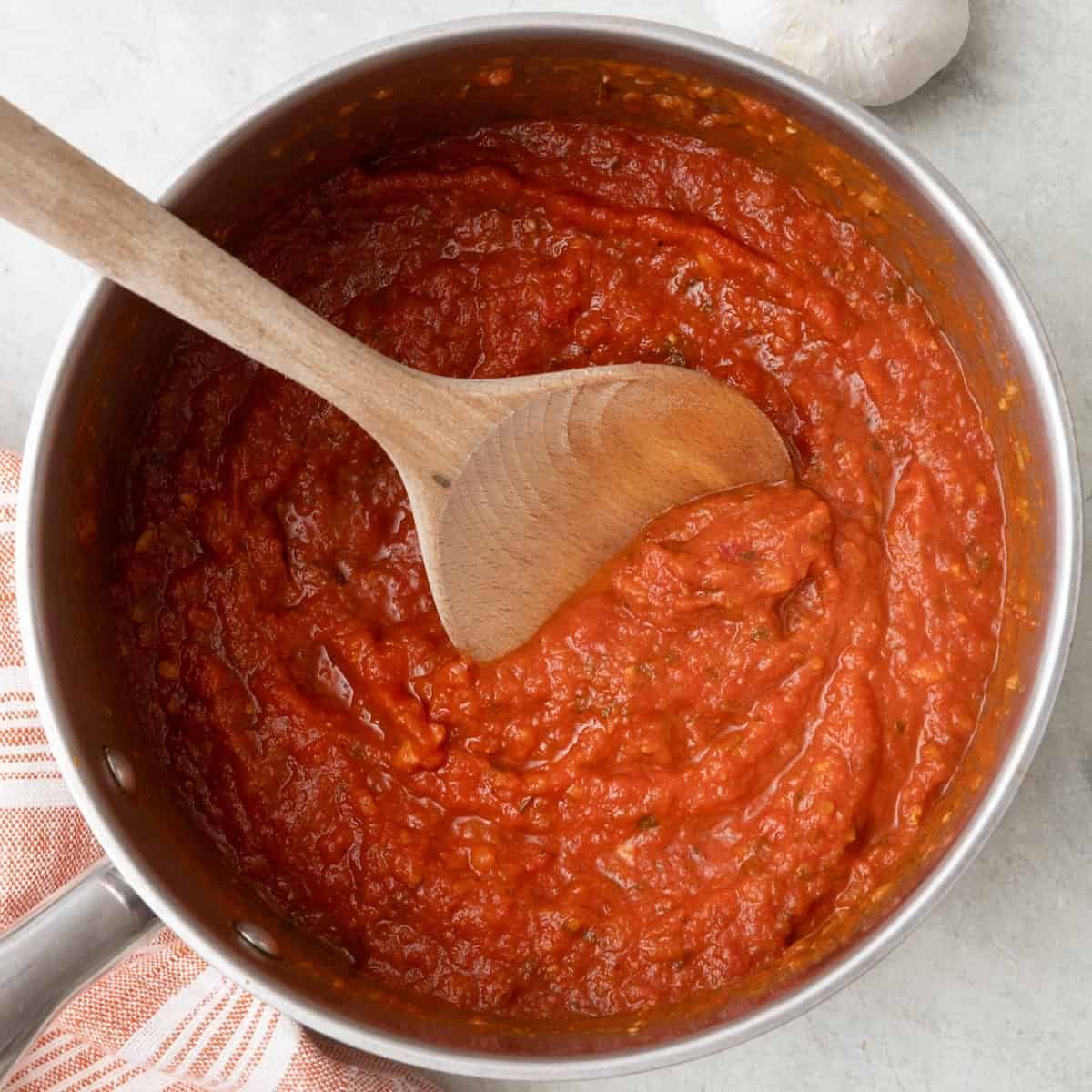
How to Make Pizza Sauce
Ingredients
- 2 tablespoons olive oil
- 1 small onion diced
- 3 garlic cloves minced
- 4 tablespoons tomato paste
- 1 28 ounce can whole tomatoes
- 2 teaspoons oregano
- 1 teaspoon dried basil
- ¾ teaspoon salt
- ¼ teaspoon crushed red pepper
- 1 ½ teaspoons sugar or to taste
Instructions
- Add oil to a large pan and heat over medium until shimmering. Add onions and saute until soft and translucent, about 2-3 minutes. Add garlic and saute until fragrant, about 1 minute. Then add the tomato paste and cook for about 3 minutes until the color has deepened.
- Add canned tomatoes, dried oregano and basil, salt, red pepper flakes, and sugar. Use a wooden spoon to break the tomatoes into small pieces. Bring sauce to a boil and reduce heat to a simmer over medium heat and cook for 25 minutes, stirring occasionally.
- After cooking, use an immersion blender or carefully transfer the sauce to a food processor/blender. Blend until smooth and no chunks of tomatoes remain. Use sauce as desired.
Equipment
- Mason Jar – 16 ounces for storage
Notes
Nutrition
Nutrition information provided is an estimate. It will vary based on cooking method and specific ingredients used.





